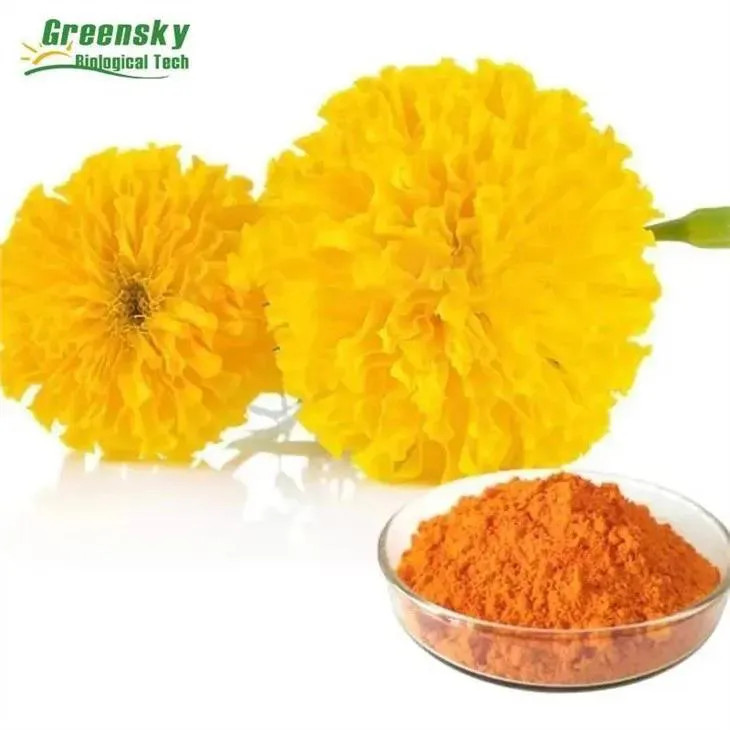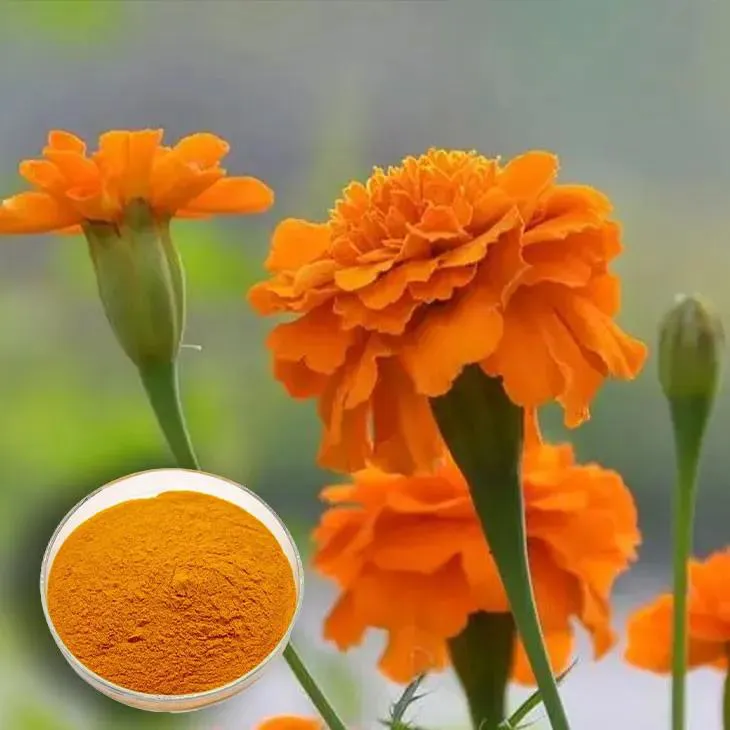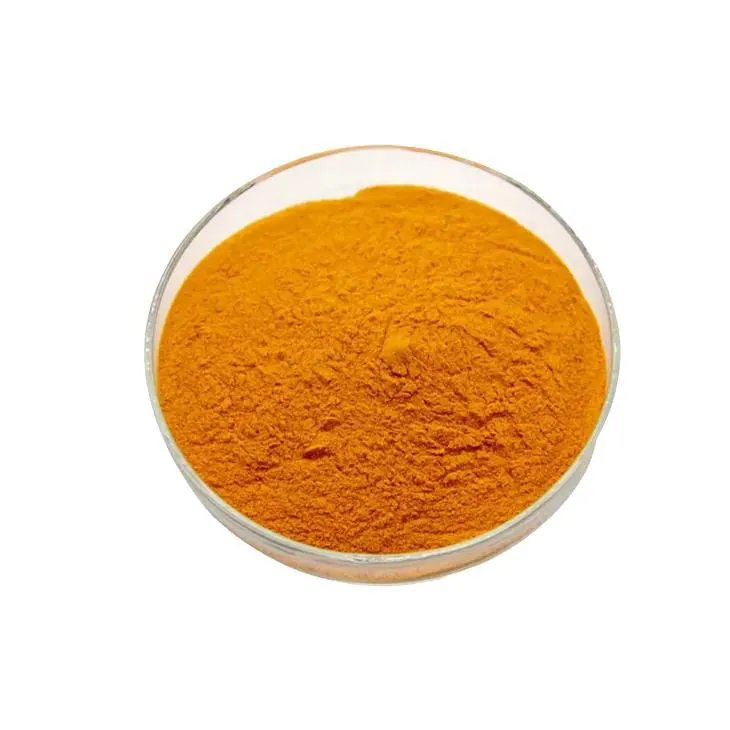- 0086-571-85302990
- sales@greenskybio.com
Marigold Extract: From Leaves to Extraction.
2024-11-12

1. Introduction
Marigold, a widely known plant, has been attracting significant attention due to the valuable extract that can be obtained from it. The Marigold Extract has found applications in numerous industries, including cosmetics, medicine, and food. Understanding the process from the marigold leaves to the extraction of its beneficial components is crucial for maximizing its potential.

2. Characteristics and Components of Marigold Leaves
2.1 Physical Characteristics
Marigold leaves are typically green in color, with a somewhat oval shape. They have a smooth texture on the upper surface and a slightly hairy underside. The size of the leaves can vary depending on the variety of marigold, but they are generally small to medium - sized.
2.2 Chemical Components
Marigold leaves contain a rich array of chemical compounds. Flavonoids are one of the major components, which are known for their antioxidant properties. These flavonoids include Quercetin, kaempferol, and luteolin. Another important group of compounds are the carotenoids, such as lutein and zeaxanthin. These are pigments that give the marigold its characteristic color and also have significant health - promoting properties. Additionally, marigold leaves contain phenolic acids, which contribute to their antioxidant and anti - inflammatory activities.
3. Extraction Methods
3.1 Solvent Extraction
- Selection of Solvent: The first step in solvent extraction is to choose an appropriate solvent. Commonly used solvents include ethanol, methanol, and hexane. Ethanol is a popular choice as it is relatively safe, can dissolve a wide range of compounds, and is easily available. For example, in a typical marigold leaf extraction process, a certain percentage of ethanol solution (such as 70% ethanol) may be used.
- Preparation of the Sample: The marigold leaves need to be properly prepared before extraction. This involves cleaning the leaves to remove any dirt or impurities. Then, the leaves are usually dried, either in the sun or in a drying oven at a controlled temperature. Once dried, the leaves are ground into a fine powder to increase the surface area for better extraction.
- Extraction Process: The powdered marigold leaves are placed in a suitable container, and the selected solvent is added. The mixture is then stirred or shaken for a certain period of time, which can range from a few hours to several days, depending on the nature of the compounds to be extracted and the extraction efficiency desired. After that, the mixture is filtered to separate the liquid extract (containing the dissolved marigold components) from the solid residue (the remaining leaf material).
- Concentration and Purification: The obtained liquid extract may be further concentrated to increase the concentration of the desired compounds. This can be done through methods such as evaporation under reduced pressure. To purify the extract, techniques like chromatography may be employed to separate different components based on their chemical properties.
3.2 Supercritical Fluid Extraction
- Principle of Supercritical Fluids: Supercritical fluid extraction utilizes the properties of a supercritical fluid, which is a substance that is at a temperature and pressure above its critical point. For example, carbon dioxide (CO₂) is a commonly used supercritical fluid in Marigold Extraction. At supercritical conditions, CO₂ has properties between those of a gas and a liquid, allowing it to penetrate the marigold leaves effectively and dissolve the target compounds.
- Extraction System Setup: A supercritical fluid extraction system consists of a pump to pressurize the supercritical fluid, an extraction vessel where the marigold leaves are placed, and a separator to separate the extracted components from the supercritical fluid. The pressure and temperature in the system are carefully controlled to maintain the supercritical state of the fluid.
- Extraction Process: The marigold leaves are placed in the extraction vessel. Supercritical CO₂ is pumped into the vessel at the appropriate pressure and temperature. The supercritical CO₂ diffuses into the leaf matrix, dissolves the flavonoids, carotenoids, and other target compounds. Then, the fluid containing the dissolved compounds is transferred to the separator. By changing the pressure and temperature in the separator, the supercritical CO₂ reverts to a gas state, leaving behind the concentrated Marigold Extract.
- Advantages over Solvent Extraction: Supercritical fluid extraction has several advantages over solvent extraction. It is a more environmentally friendly method as it does not leave behind solvent residues. It also offers better selectivity, allowing for the extraction of specific compounds with higher purity. Moreover, the extraction process is relatively fast and can be more easily automated.

4. Significance of Marigold Extract in Different Fields
4.1 Cosmetics
- The antioxidant properties of marigold extract make it a valuable ingredient in cosmetics. Antioxidants help to protect the skin from damage caused by free radicals, which are unstable molecules that can lead to premature aging, wrinkles, and other skin problems. Marigold extract, rich in flavonoids and carotenoids, can be incorporated into various skincare products such as creams, lotions, and serums.
- Marigold extract also has anti - inflammatory properties. It can soothe irritated skin, reduce redness, and is beneficial for treating skin conditions such as eczema and dermatitis. In addition, its natural pigments can add a pleasant color to cosmetic products without the need for synthetic dyes.
4.2 Medicine
- In the field of medicine, marigold extract has shown potential in various areas. Its antioxidant and anti - inflammatory properties make it a candidate for treating inflammatory diseases. For example, it may be used in the development of drugs for arthritis, where reducing inflammation is a key factor in alleviating pain and improving joint function.
- Some studies have suggested that the carotenoids in marigold extract, such as lutein and zeaxanthin, are beneficial for eye health. They may help to prevent age - related macular degeneration (AMD) and cataracts by protecting the eyes from oxidative stress.
- Marigold extract also has antimicrobial properties. It can inhibit the growth of certain bacteria and fungi, which could potentially be used in the development of topical antimicrobial agents for wound healing or treating skin infections.
4.3 Food
- As a natural antioxidant, marigold extract can be used to preserve food. It can prevent the oxidation of fats and oils in food products, thereby extending their shelf life. For example, it can be added to edible oils to reduce rancidity.
- The carotenoids in marigold extract, especially lutein, are important for human health. Lutein is known to be beneficial for eye health, and adding marigold extract to food products such as fortified cereals or dietary supplements can help consumers meet their daily requirements of this nutrient.
- Marigold extract can also be used as a natural colorant in the food industry. It can provide a yellow - orange color to food products, replacing synthetic food colorings which may have potential health risks.

5. Conclusion
Marigold extract has a wide range of potential applications in cosmetics, medicine, and food industries. Understanding the characteristics of marigold leaves and the extraction methods is essential for harnessing its full potential. Solvent extraction and supercritical fluid extraction are two important methods, each with its own advantages. The significance of marigold extract in different fields lies in its antioxidant, anti - inflammatory, antimicrobial, and health - promoting properties. As research continues, it is expected that more applications and benefits of marigold extract will be discovered, further enhancing its value in various industries.
FAQ:
What are the main components in marigold leaves?
Marigold leaves contain various components. They are rich in flavonoids, carotenoids such as lutein and zeaxanthin, and other phytochemicals. These components play important roles in the properties and applications of marigold extract.
What is solvent extraction for marigold extract?
Solvent extraction for marigold extract involves using a suitable solvent to dissolve the desired compounds from the marigold leaves. Commonly used solvents include ethanol, hexane, etc. The process typically includes steps like grinding the leaves, adding the solvent, and then separating the extract from the solid residue through filtration or centrifugation.
How does supercritical fluid extraction work for marigold extract?
In supercritical fluid extraction for marigold extract, a supercritical fluid (usually carbon dioxide) is used. The supercritical fluid has properties between a gas and a liquid. It can effectively penetrate the plant material, dissolve the target compounds, and then when the pressure is changed, the extract can be separated from the fluid. This method is often considered more environmentally friendly and can produce a purer extract compared to some traditional solvent extraction methods.
What are the antioxidant properties of marigold extract used for in cosmetics?
In cosmetics, the antioxidant properties of marigold extract are used to protect the skin from oxidative stress. Oxidative stress can be caused by factors such as UV radiation and pollution. The antioxidants in marigold extract can neutralize free radicals, which helps in reducing skin aging, preventing wrinkles, and maintaining the overall health and appearance of the skin.
What are the potential health benefits of marigold extract in medicine?
Marigold extract has potential health benefits in medicine. Its anti - inflammatory properties can be beneficial for treating various inflammatory conditions. It may also have antibacterial and antiviral effects in some cases. Additionally, the antioxidant components may contribute to overall health by protecting cells from damage, which could potentially be relevant in the prevention of certain diseases.
Related literature
- Marigold (Tagetes erecta L.): Phytochemistry, Pharmacology, and Medicinal Properties"
- "Extraction and Characterization of Bioactive Compounds from Marigold (Tagetes spp.)"
- "Marigold Extract in Cosmetics: Properties and Applications"
- ▶ Hesperidin
- ▶ Citrus Bioflavonoids
- ▶ Plant Extract
- ▶ lycopene
- ▶ Diosmin
- ▶ Grape seed extract
- ▶ Sea buckthorn Juice Powder
- ▶ Fruit Juice Powder
- ▶ Hops Extract
- ▶ Artichoke Extract
- ▶ Mushroom extract
- ▶ Astaxanthin
- ▶ Green Tea Extract
- ▶ Curcumin
- ▶ Horse Chestnut Extract
- ▶ Other Product
- ▶ Boswellia Serrata Extract
- ▶ Resveratrol
- ▶ Marigold Extract
- ▶ Grape Leaf Extract
- ▶ New Product
- ▶ Aminolevulinic acid
- ▶ Cranberry Extract
- ▶ Red Yeast Rice
- ▶ Red Wine Extract
-
Panax Ginseng Leaf Extract
2024-11-12
-
Marigold Extract
2024-11-12
-
Alisma Extract
2024-11-12
-
Almond Extract Powder
2024-11-12
-
Yellow Pine Extract
2024-11-12
-
Purple Sweet Potato Extract
2024-11-12
-
Hedyotis Diffusa Extract
2024-11-12
-
Hesperidin
2024-11-12
-
Honeysuckle Pollen
2024-11-12
-
Hawthorn Extract
2024-11-12




















